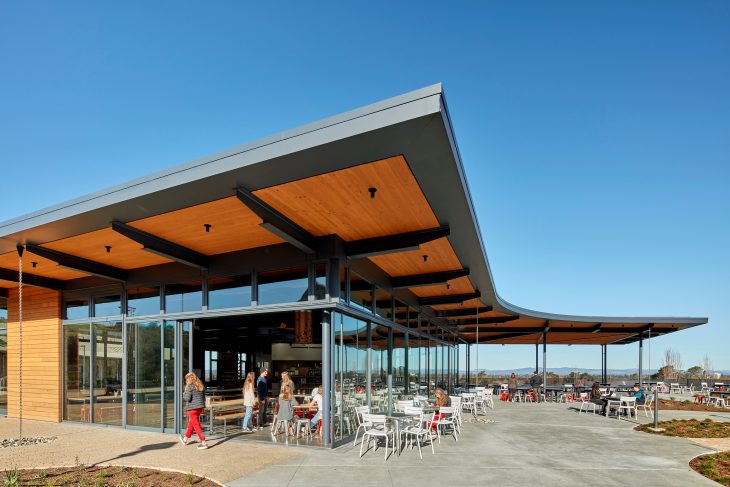Concrete steps designers can take at each phase of project work to ensure healthier materials.

Designers have told me that they have been reluctant to implement healthier materials on their projects for a myriad of reasons, including: they’re too busy, the client doesn’t care, the project manager doesn’t want them spending extra time, they don’t understand (or want to get bogged down in) the chemistry. A host of reasons make my colleagues fear that doing what they agree is a better thing, if not the right thing to do on projects, will imperil doing the thing they’ve been tasked with: creating a beautiful, functional space on budget and on schedule.
I’m sure there was similar sentiment decades ago, when the Americans with Disabilities Act was introduced. Universal design has its frustrations for the designer, but overall has led to better access to more people – surely it was the right thing to do. Even just meeting the code to make our designs ADA compliant, the floor was raised. “Best practices” became even better.
If you’re not convinced, or don’t know why providing healthier materials in projects should be the right thing to do, I recommend checking out SixClasses.org and watching the series of short videos for a very quick primer. Other good resources include the “Learn More” section of Perkins+Will’s Transparency Site, and the AIA Materials Matter page.

For those who need a firmer directive (or could use one to help convince others), while reducing toxicity in buildings is not yet part of the building code, the AIA has recognized human health and environmental health as integral to architectural practice. Rule 6.501, code of ethics: Members shall consider with their clients the environmental effects of their project decisions. Within this section, it goes on to specifically call out exposure to toxins and the potential for pollution. Curiously, neither of the two major interior design professional associations, IIDA nor ASID*, have any similar statements within their code of conduct, though the majority of what presents an exposure risk are the interior finishes we are professionally responsible for recommending and specifying. By now everyone should be familiar with this statistic from the EPA, that we spend 90 percent of our time indoors, necessarily surrounded by those finishes. While the vast majority of permitted work is signed by an architect, it would go a long way toward educating all members of the design community if there was a broader effort to bring this important topic to the forefront, whether through codes of professional conduct or other means.
*UPDATE: ASID has indeed addressed the responsibility of design professionals in regard to material health. After the publication of this article, Workplace Design Magazine received the following statement from ASID:
“ASID is in complete agreement on the importance of healthy materials within the built environment and the critical role that interior designers play. Because interior designers are one of the guardians of public health, safety, and welfare in the built environment, on May 9, 2019, the ASID Board of Directors adopted the following official public policy position statement:
Though ASID recognizes and embraces the importance of testing and using new and safe chemicals and other materials in building design and construction, asbestos’ and other similar toxic chemicals’ long and largely harmful history in construction leads the Society to oppose their use. Only substances and methodologies proven to be benign to construction professionals, manufacturing workers, designers, and occupants should be used in design and construction.
This statement was crafted and recommended to the Board by the ASID Construction Codes & Standards Committee that has jurisdiction over matters related to green, wellness, and safety codes and standards.”
The AIA has published a very helpful manual, Prescription for Healthier Materials: A Design and Implementation Protocol, which outlines in detail several frameworks for approaching healthy materials on a project. This document provides a variety of approaches and specific tools that can be used. Having contributed to the manual, I can highly recommend it. However, for those of you looking for a simpler, more straight-forward approach, I can offer the following, based on my experience of applying healthier materials to projects and in learning from my colleagues what has been successful:
- Step One: Set goals by project
- Step Two: Establish baseline (healthier) materials
- Step Three: Look for transparency
- Step Four: Assess the data
- Step Five: Provide resources
Step One should be taken at project kick-off, preferably as part of the overall sustainability conversations. Bringing the issues to the attention of the client, and the larger design and construction team, is the essential first step. Even if goals are not established on your first try, it is an important opportunity for educating stakeholders about why healthier materials should be part of their project. Ideally, this step results in client buy-in, and provides the design team the authority to pursue this work as a recognized part of the project. Assuming goals are set, they and the progress toward them should be reviewed at each milestone submittal during the project, with a final report at close out. Each of these points in time is an opportunity to engage the client with the reasons behind making the effort: ultimately, to reduce health hazards to people, and to reduce environmental pollution and health risks associated with the production and use of hazardous ingredients.
Step two starts with schematic design. Complete steps three and four at each phase of the project, updating product information as the project evolves and selections become specifications. Complete step five as part of the project closeout.

Step One: Setting Goals – Project Kick-Off
This step involves first selecting a framework to follow (see AIA Healthier Materials Protocol for full descriptions). Typical frameworks are:
- Avoidance lists (i.e., Red List, Precautionary List, SixClasses, etc.)
- Health outcomes – i.e., avoid carcinogens for a cancer treatment center
- Promoting transparency in general or a specific certification – i.e., use only products that have committed to public transparency (ie HPD or Declare Label) or agree to a certification type (C2C Silver or better, for example).
Setting goals is vital to making this work a legitimate part of the project. But without agreed-upon metrics, how will you know if you’ve been successful at meeting the goal? Again, the Materials Protocol offers numerous ways of tracking any of the goals that may be used. The key to this step is picking goals and metrics that work for your project and project team, and getting all stakeholders (general contractor, design team, client) to agree. All parties will be responsible, at varying times, for decisions that will lead to the success or failure in meeting the established goals.
For so many reasons, we don’t always get buy-in for this work from our client. That doesn’t mean many of us don’t try anyway. All the steps can still be followed “under the radar” and the resulting project will be less polluted with toxins than if no effort had been made. When the healthier product is meeting the parameters of good design, it’s not always necessary to point out its other attributes.

Step Two: Establish Baseline – Design Phases
At schematic design phase, and as the project develops, identify generic product types early: what is necessary, with a focus on performance requirements. For example, is carpet necessary? One commercial tenant fit-out client may find that eliminating carpet from certain areas of the project works well with their desired aesthetic, while another will value the acoustic absorption it brings to the space. Another example: stain resistant treatments on upholstery fabric. Are these necessary in a small lobby that sees very light traffic?
Identifying major product types is absolutely necessary to the project (paint, drywall, resilient flooring, carpet, etc.). Use the use Common Building Products database on Pharos or at HomeFree.HealthyBuilding.net to identify healthier product types (generically). Use these resources to identify what health hazards are typically present in that material. If resilient flooring is a project requirement, what type – vinyl, linoleum, rubber, other plastics – has the fewest health hazards, or best meet the healthier materials goals? Identifying this at the onset will reduce time and frustration spent on reselecting products later in the project, when there may be a domino effect.
The information and pre-selections you have made should be documented into the Basis of Design or schematic phase finish schedule, along with the metrics for each. How do these stack up toward meeting the ultimate goal?
The other benefit to identifying generic product types is you now may do some quick recon. Preview available transparency documents by visiting the major databases (mindful Materials, HPD Repository, Declare Label products, etc.), and searching by product type. This will reveal products and manufacturers to start with, when you’re ready to start pulling options.

Step Three: Look for Transparency – Design development, CDs, and CA
As you pull selections to present and finalize the design, the designer should be mindful to make selections that actually meet the project goals – don’t expect this is something that can be “fixed” or easily reselected later in the project. In fact, the more you can tie each selection to a project goal the less likely that item will be considered for “value engineering”.
While healthier material options are still far from mainstream, there are far more available now, and that pool is growing larger and deeper by the day. Finding these products can still be challenging, but a great starting point is the Mindful Materials library, which allows users to filter by specific certificates or reports (i.e., HPD, Declare, C2C) and browse available products in a type category. It’s worth creating a login to access the filter options. For example, I can select a general material category (“ceilings” – 98 listings), add a filter for Cradle to Cradle Certifications (five listings), quickly change that to Declare (four listings) or HPDs (61 listings), and browse the options – including checking the expiration dates of those certifications.
Depending on your goals and metrics, there are other resources; typically the websites of any given certificate or standard will offer a database of products that have participated.
Once the initial hard work of selection and specification is complete, the design team needs to stay engaged through the review of submittals to ensure that the final project is as planned. Specification language can be added in Division 1 to ensure alternates and substitutions, posed by the contractor, meet the same requirements as the base selection. During construction administration, submittals need to be reviewed for conformance to the project goals; substitutions, if allowed, will affect the metrics and need to be included in the final report out; this too can be established in the specifications, but needs to be checked per submittal.
I have found it useful, in discussion with the client around progress toward the healthy materials goals, to create a list of the products that are not meeting the stated goal, along with potential alternates. For example, a vinyl membrane roofing system may not meet the agreed-upon avoidance list, but it does meet the client’s maintenance and performance requirements. Reviewing this list at each phase allows me to highlight where alternates are found and agreed to (i.e., ceramic or metal pipe shroud in lieu of a vinyl sock under the ADA lavatories) or have been agreed to not meet the goal (like the roofing). At the end of the project, a less than 100 percent “score” can be seen in context, and provide valuable insights for future projects of a similar nature. It may also prompt the client-organization to review their own standards and policies with an eye to reducing built in toxicity.

Step Four: Assess the Data – Design Development Through End of Project
Using the product data you have gathered, assess the products you’ve selected (or compare products to make a selection) against the goals set at the beginning of the project. How you proceed will be dependent on the goal and the metric for measuring that goal.
If using an avoidance list, you could review an HPD, Declare Label, or Manufacturer’s Ingredient List to confirm that specific chemicals are not present. This is where the CAS number and ppm becomes a factor; many chemical names are somewhat generic, so the Chemical Abstract Service registry number ensures everyone is referring to the same thing. Also, the degree to which an ingredient is reported is measured in parts per million; 100 ppm is a finer grain than 1000 ppm, and some ingredients won’t show up at 1000ppm (much less at 10,000ppm, which is the minimum for a Safety Data Sheet, one of many reasons that document is not considered “transparent” for use in evaluating ingredients). To find the CAS number on a Declare Label, you must use the Declare product database; the CAS number is not reported on the “label” but it is reported on the site.
The Health Product Declaration (HPD) is the gold standard for material ingredient reporting – when it is fully filled out (preferably by a third party) to 100ppm. From this document, individual ingredients and health hazards can be reviewed directly.
If avoiding a specific health hazard is the goal, you must be able to identify all the CAS numbers in a product. If you have a list of ingredients without health hazards, you can use the Pharos Chemicals and Materials database. Searching by CAS number will result in a listing of health hazards, as well as the GreenScreen assessment (if there is one).
While the C2C label represents a significant investment on the part of the manufacturer, it does not represent transparency. It does provide a path toward optimization – continuous improvement toward healthier ingredients and more sustainable production and policies, which is important and laudable in the search for healthier materials. A thorough understanding of how the program works is necessary to use this certification in an assessment of material health; it could more readily be used as a baseline or benchmark goal for product selection.

Step Five: Provide Resources – Project Close Out and Beyond
Make a final report to the project team on the materials health goal. Celebrate how far you have come! I’ve had instances of working with the client’s marketing team to craft language they can use internally and externally to make their healthier project a point of distinction for their brand.
Update your in-house library to highlight and promote products and manufacturers with transparency documents (ie, those listed in Mindful Materials, HPD Repository, and Declare Label). For products that are not in those databases, but still on your shelves – reach out to those manufacturers and/or local reps, and let them know why they may be removed or “demoted” within your library. Ask why they aren’t listed yet in Mindful Materials, and what they are doing to reduce health hazards in their products. Being able to reference an active project that they may not be considered for, or were de-selected from, provides compelling data for a manufacturer to consider making potentially costly investments. Starting the dialogue is huge; helping your local representatives “speak the language” of transparency and materials health is part of the education necessary within our industry as a whole.
Create a listing of product certifications and reports that you used throughout your healthier project. Identify those that you think should be an office/firm-wide “gold standard” for healthier products, and rank the others as well; consider incorporating this information into your library protocols. Which did you find to provide the most useful information for making an informed decision? Offer some in-house training to your colleagues focusing on what worked for you.
Ensure the work you did throughout this project is easy to find again. Use what worked here as a starting point for your next project; share your learnings – What was challenging to find? What was surprisingly easy to improve? – with other project teams in your office and through local industry association presentations, even nationally via conferences or written articles.
Take a moment to estimate the amount of time you spent doing “extra” work to meet the healthy materials goal. Identify (take a guess) how much of that time will likely reduce with experience and practice, and how much (if any) is a premium associated with the effort. Share this analysis with your office leadership, and brainstorm how to further reduce any of the identified premium (real or perceived).
Making this information clear and readily available to your colleagues will make the process that much easier to take up on the next project. Ultimately, we need to create the positive feedback loop with manufacturers by supporting the healthier options with specifications (and sales) to drive more healthier options…and ultimately healthier spaces being built.


